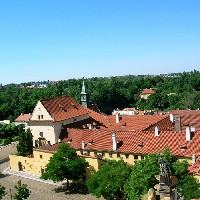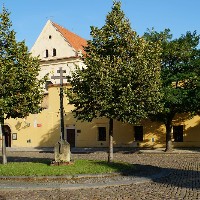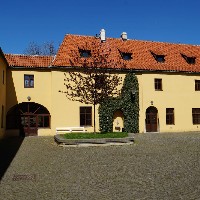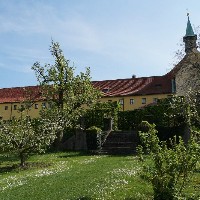Breadcrumbs navigation
Church of the Virgin Mary Angelic (Klášterní kostel Panny Marie Královny Andělů)
This simple single-aisled sacred building from 1602, with square chapels at the sides and a small flèche, is part of the premises of the Capuchin monastery. In 1757, cannons were fired at the church during the Prussian siege of Prague the cannon balls have been mounted in the façade to commemorate this event. The church is a favourite among Praguers at Christmas – it’s famous for its nativity scene dating from 1780 and featuring 48 life-sized figures.
- Monuments & Architecture
- church
Practical information
REGULAR MASSES:
- Su and public holidays 8.30
- Mo - Fr 17.00
Sightseeing possible before and after the mass or by appointment.
UNIQUE CAPUCHIN NATIVITY SCENE
Nativity scene dating from 1780 featuring 48 life-sized figures made of wood and straw with faces of plaster and paper. The figures are dressed in real clothes treated with resin. The Baby Jesus lies in the hay until Epiphany, then the Virgin Mary holds him in her arms.
It is the work of Capuchin monk named Kašpar.
We offer lodging/short term accommodation not only for students and youth but also for families, choirs and other kinds of groups or individuals. There are 4 rooms available with capacity of 32 beds in total, common sanitary facilities and one common room with a small kitchen to prepare simple meals. During summer from July to August total capacity increases by 20 bedrooms, 1-3 beds each.
Contacts
- Church of the Virgin Mary Angelic (Klášterní kostel Panny Marie Královny Andělů)
- Loretánské náměstí 6
- 118 00 Praha 1 – Hradčany
- +420222760071
Object history
This monastery is the oldest Capuchin monastery in the Bohemian territory. It was established in the Lobkowicz garden in 1600 by the order’s Minister General himself, Lawrence of Brindisi, who was later canonized. In 1602, the Church of Virgin Mary Angelic was consecrated, corresponding to the Capuchin needs - very simple, single-aisle, with no tower, just a little sanctus spire from which the bells rang during the mass. The interior decorations are just as simple; recently a modern relief Calvary was added by Karel Stádník. There is an old Bethlehem in one of the side chapels, which dates back to the year 1700 and has wooden and straw figures with faces of plaster and paper. The figures are dressed in real clothes treated with resin. The Bethlehem was made by a Capuchin monk named Kašpar. Cannon balls which hit the monastery during the Prussian bombing in 1757 have been installed in the church facade.
The monastery convent was built gradually during the 17th century and the 1st half of the 18th century. The monastery is interconnected with Loretta via a roofed suspended corridor on pillars. The monastery garden was in the neighbourhood of the city ramparts, which allowed the Capuchins to let the Imperial army enter the city in 1632, under the leadership of Albrecht of Valdštejn, who then ended the six-month Saxon occupation of Prague. During the Protectorate, the SS headquarters established a prison here. After the war, the friars returned, but only for a while, as they were violently moved out after the communist coup. The monastery was not returned to the Capuchins before 1990. The Capuchins are the traditional keepers of the Loretta pilgrimage place.
Information source: www.kapucini.cz




